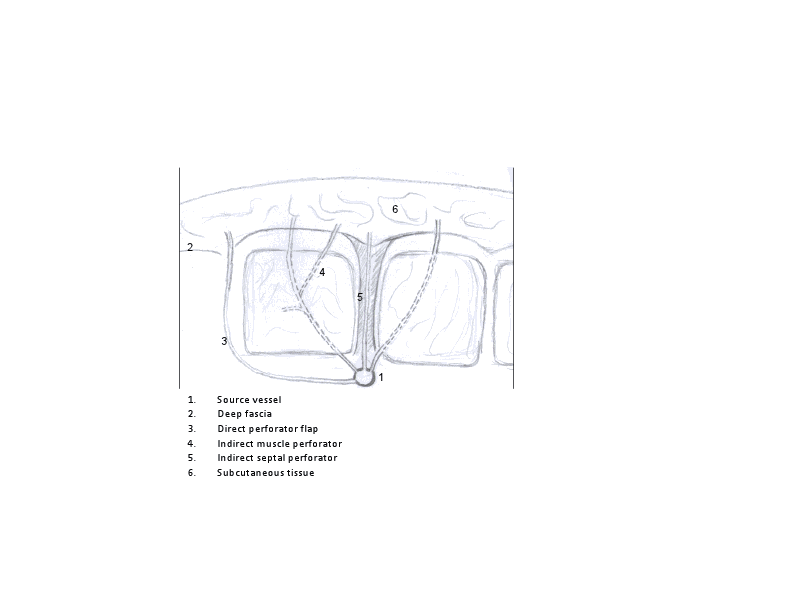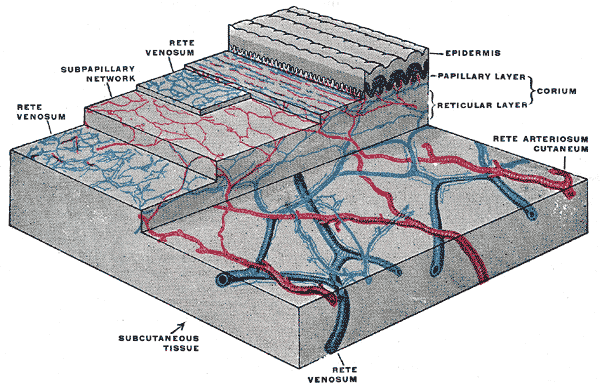|
Free Flap
The terms free flap, free autologous tissue transfer and microvascular free tissue transfer are synonymous terms used to describe the "transplantation" of tissue from one site of the body to another, in order to reconstruct an existing defect. "Free" implies that the tissue is completely detached from its blood supply at the original location ("donor site") and then transferred to another location ("recipient site") and the circulation in the tissue re-established by anastomosis of artery(s) and vein(s). This is in contrast to a "pedicled" flap in which the tissue is left partly attached to the donor site ("pedicle") and simply transposed to a new location; keeping the "pedicle" intact as a conduit to supply the tissue with blood. Various types of tissue may be transferred as a "free flap" including skin and fat, muscle, nerve, bone, cartilage (or any combination of these), lymph nodes A lymph node, or lymph gland, is a kidney-shaped Organ (anatomy), organ of the lymphatic ... [...More Info...] [...Related Items...] OR: [Wikipedia] [Google] [Baidu] |
Free Flap Hariadhi
Free may refer to: Concept * Freedom, the ability to act or change without constraint or restriction * Emancipate, attaining civil and political rights or equality * Free (''gratis''), free of charge * Gratis versus libre, the difference between the two common meanings of the adjective "free". Computing * Free (programming), a function that releases dynamically allocated memory for reuse * Free software, software usable and distributable with few restrictions and no payment *, an emoji in the Enclosed Alphanumeric Supplement block. Mathematics * Free object ** Free abelian group ** Free algebra ** Free group ** Free module ** Free semigroup * Free variable People * Free (surname) * Free (rapper) (born 1968), or Free Marie, American rapper and media personality * Free, a pseudonym for the activist and writer Abbie Hoffman * Free (active 2003–), American musician in the band FreeSol Arts and media Film and television * ''Free'' (film), a 2001 American dramedy * '' F ... [...More Info...] [...Related Items...] OR: [Wikipedia] [Google] [Baidu] |
Frank Hölzle
Frank Hölzle (; born 13 February 1968 in Calw) is a German surgeon. He is a professor of oral and maxillofacial surgery at the RWTH Aachen University. He is chairman and head of the Department of Oral and Maxillofacial Surgery. Hölzle is known for his work in the fields of plastic facial reconstruction with a focus on micro surgery. He is also specialised for the treatment of tumor diseases in the head and neck region, and of malformations like cleft lip and palate. Biography Hölzle was born in Calw and grew up in the Black Forest. In Calw he was educated at the Herrmann-Hesse-Gymnasium. He studied medicine and dentistry at the Free University of Berlin, at the Humboldt University of Berlin, at the University of Glasgow and at the University College London Medical School from 1989 to 1998. He received his doctoral title in human medicine in 1995. In 1998, he was promoted to doctor of dentistry. From 1999 to 2000, Hölzle was a scientific employee at the Department of Oral ... [...More Info...] [...Related Items...] OR: [Wikipedia] [Google] [Baidu] |
Perforator Flaps
Perforator flap surgery is a technique used in reconstructive surgery where skin and/or subcutaneous fat are removed from a distant or adjacent part of the body to reconstruct the excised part. The vessels that supply blood to the flap are isolated perforator(s) derived from a deep vascular system through the underlying muscle or intermuscular septa. Some perforator vein, perforators can have a mixed septal and intramuscular course before reaching the skin. The name of the particular flap is retrieved from its perforator and not from the underlying muscle. If there is a potential to harvest multiple perforator flaps from one vessel, the name of each flap is based on its anatomical region or muscle. For example, a perforator that only traverses through the septum to supply the underlying skin is called a septal perforator. Whereas a flap that is vascularised by a perforator traversing only through muscle to supply the underlying skin is called a muscle perforator. According to the dis ... [...More Info...] [...Related Items...] OR: [Wikipedia] [Google] [Baidu] |
List Of Plastic Surgery Flaps
Several techniques for creating flap (surgery), flaps are used in plastic surgery. List of flaps See also * Flap (surgery) * Perforator flaps References {{Skin and subcutaneous tissue procedures , state=collapsed Plastic surgical procedures ... [...More Info...] [...Related Items...] OR: [Wikipedia] [Google] [Baidu] |
Microsurgery
Microsurgery is a general term for surgery requiring an operating microscope. The most obvious developments have been procedures developed to allow anastomosis of successively smaller blood vessels and nerves (typically 1 mm in diameter) which have allowed transfer of tissue from one part of the body to another and re-attachment of severed parts. Microsurgical techniques are utilized by several specialties today, such as general surgery, ophthalmology, orthopedic surgery, gynecological surgery, otolaryngology, neurosurgery, oral and maxillofacial surgery, endodontic microsurgery, plastic surgery, podiatric surgery and pediatric surgery. History Otolaryngologists were the first physicians to use microsurgical techniques. A Swedish otolaryngologist, Carl-Olof Siggesson Nylén (1892–1978), was the father of microsurgery. In 1921, in the University of Stockholm, he built the first surgical microscope, a modified monocular Brinell-Leitz microscope. At first he used it f ... [...More Info...] [...Related Items...] OR: [Wikipedia] [Google] [Baidu] |
TRAM Flap
Breast reconstruction is the surgical process of rebuilding the shape and look of a breast, most commonly in women who have had surgery to treat breast cancer. It involves using autologous tissue, prosthetic implants, or a combination of both with the goal of reconstructing a natural-looking breast. This process often also includes the rebuilding of the nipple and areola, known as nipple-areola complex (NAC) reconstruction, as one of the final stages. Generally, the aesthetic appearance is acceptable to the woman, but the reconstructed area is commonly completely numb afterwards, which results in loss of sexual function as well as the ability to perceive pain caused by burns and other injuries. Timing Breast reconstruction can be performed either immediately following the mastectomy or as a separate procedure at a later date, known as immediate reconstruction and delayed reconstruction, respectively. The decision of when breast reconstruction will take place is patient-specif ... [...More Info...] [...Related Items...] OR: [Wikipedia] [Google] [Baidu] |
Rotation Flap
A rotation flap is a semicircular skin flap that is rotated into the defect on a fulcrum point. Rotation flaps provide the ability to mobilize large areas of tissue with a wide vascular base for reconstruction. The flap must be adequately large, and a large base is necessary if a back-cut will be needed to lengthen the flap. If the flap is too small, the residual defect can be covered by mobilizing the surrounding tissue. A drawback of rotation flaps is the extended cutting and undermining needed to create the flap, thus increasing the risk of hemorrhage and nerve damage. This term is often used in contrast with the term "free flap" where the transferred tissue is completely detached. See also *Flap (surgery) *Free flap *Perforator flaps *List of plastic surgery flaps Several techniques for creating flap (surgery), flaps are used in plastic surgery. List of flaps See also * Flap (surgery) * Perforator flaps References {{Skin and subcutaneous tissue procedures , state=c ... [...More Info...] [...Related Items...] OR: [Wikipedia] [Google] [Baidu] |
Flap (surgery)
Flap surgery is a technique in plastic surgery, plastic and reconstructive surgery where Tissue (biology), tissue with an intact blood supply is lifted from a donor site and moved to a recipient site. Flaps are distinct from Graft (surgery), grafts, which do not have an intact blood supply and relies on the growth of new blood vessels. Flaps are done to fill a defect such as a wound resulting from injury or surgery when the remaining tissue is unable to support a graft, wound contraction is to be avoided or to rebuild more complex anatomic structures like breasts or jaws. Flaps may also carry with them tissues such as muscle and bone that may be useful in the ultimate reconstruction. Uses Flap surgery is a technique essential to Plastic surgery, plastic and reconstructive surgery. A flap is defined as tissue that can be moved to another site and has its own Circulatory system, blood supply. This is in comparison to a Skin grafting, skin graft which does not have its own blood su ... [...More Info...] [...Related Items...] OR: [Wikipedia] [Google] [Baidu] |
Necrosis
Necrosis () is a form of cell injury which results in the premature death of cells in living tissue by autolysis. The term "necrosis" came about in the mid-19th century and is commonly attributed to German pathologist Rudolf Virchow, who is often regarded as one of the founders of modern pathology. Necrosis is caused by factors external to the cell or tissue, such as infection, or trauma which result in the unregulated digestion of cell components. In contrast, ''apoptosis'' is a naturally occurring programmed and targeted cause of cellular death. While apoptosis often provides beneficial effects to the organism, necrosis is almost always detrimental and can be fatal. Cellular death due to necrosis does not follow the apoptotic signal transduction pathway, but rather various receptors are activated and result in the loss of cell membrane integrity and an uncontrolled release of products of cell death into the extracellular space. This initiates an inflammatory response in ... [...More Info...] [...Related Items...] OR: [Wikipedia] [Google] [Baidu] |
Circulatory Anastomosis
A circulatory anastomosis is a connection (an anastomosis) between two blood vessels, such as between arteries (arterio-arterial anastomosis), between veins (veno-venous anastomosis) or between an artery and a vein (arterio-venous anastomosis). Anastomoses between arteries and between veins result in a multitude of arteries and veins, respectively, serving the same volume of tissue. Such anastomoses occur normally in the body in the circulatory system, serving as back-up routes in a collateral circulation that allow blood to flow if one link is blocked or otherwise compromised, but may also occur pathologically. Physiologic Arterio-arterial anastomoses include actual (e.g., palmar and plantar arches) and potential varieties (e.g., coronary arteries and cortical branch of cerebral arteries). There are many examples of normal arterio-arterial anastomoses in the body. Clinically important examples include: * Circle of Willis (in the brain) * Coronary: anterior interventricul ... [...More Info...] [...Related Items...] OR: [Wikipedia] [Google] [Baidu] |
Skin Graft
Skin grafting, a type of graft (surgery), graft surgery, involves the organ transplant, transplantation of skin without a defined circulation. The transplanted biological tissue, tissue is called a skin graft. Surgeons may use skin grafting to treat: * extensive wounding or physical trauma, trauma * Burn (injury), burns * areas of extensive skin loss due to infection such as necrotizing fasciitis or purpura fulminans * specific surgeries that may require skin grafts for healing to occur – most commonly removal of skin cancers Skin grafting often takes place after serious injuries when some of the body's skin is damaged. Surgical removal (excision or debridement) of the damaged skin is followed by skin grafting. The grafting serves two purposes: reducing the course of treatment needed (and time in the hospital), and improving the function and appearance of the area of the body which receives the skin graft. There are two types of skin grafts: * Partial-thickness: The more co ... [...More Info...] [...Related Items...] OR: [Wikipedia] [Google] [Baidu] |





